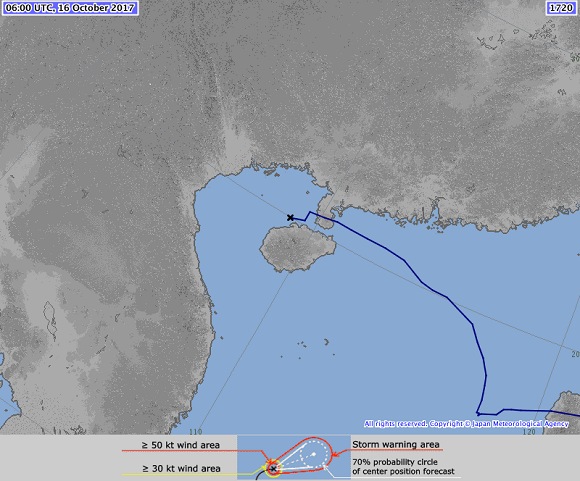Typhoon Khanun
Status: Closed
| Type of posting | Posting date(EST): | Summary | Downloads |
|---|---|---|---|
| Landfall | 10/16/2017 1:00:00 PM |
|
Landfall | Summary
Posting Date: October 16, 2017, 1:00:00 PM
Meteorological Summary
The 10th typhoon to impact China this year, Typhoon Khanun made landfall in Xuwen County at the southern end of the Leizhou Peninsula—part of the highly populated Guangdong Province—early on Sunday, with winds of more than 100 km/h. Weakening significantly after landfall, Khanun buffeted southern China, including Hainan Island, with strong winds. Heavy rainfall totals have exceeded 100 mm in some regions.
Originally forming east of the Philippines, it crossed those islands on October 12 as a severe tropical storm—known locally as Odette. As it gained strength, it swept south of Hong Kong, with the edges of the storm brushing the major financial hub before Khanun moved northwest to strike China’s southern coast.
Reported Impacts
Chinese authorities issued an orange alert for the southern coastal region, which is the second level of severity in a four-tier system. Due to this alert level, train and marine services on the Qiongzhou Strait, which connects the island Province of Hainan with the southern province of Guangdong, have been suspended since Sunday, as were construction sites, some schools, and businesses. About 48,300 fishing boats were recalled and more than 368,000 people were evacuated from the region in advance of the storm.
Hainan’s Province’s tourism industry suffered further disruption when, as of Sunday afternoon, more than 260 flights at the Meilan International Airport in the capital of Haikou had been canceled. The Leizhou Peninsula is also a major tourist region, and more than 38,200 tourists were evacuated, while 188 scenic spots in the cities of Zhanjiang, Maoming, Yangjiang, and Jiangmen were closed.
Overall, Guangdong’s population is near 108,500,000 at last census, and the province is an economic powerhouse, with a GDP of about USD 1,104.05 billion in 2014; it is also China’s largest exporter and importer of goods.
Hong Kong reported some wind damage to structures, including damage to construction scaffolding and at least one blown off roof, along with more than 80 fallen trees. Hong Kong International Airport experienced a number of delayed and canceled flights through Sunday. Ferry services between Macau and Hong Kong were suspended from Sunday morning until evening.
Exposure at Risk
With high population density along the southeast coast of China, many homes and businesses are at risk. As is often the case with China typhoons, flooding is a major concern; much of the population is located near waterways and along the coast.
Houses in coastal regions of southern and southeastern China are commonly confined masonry or reinforced concrete with clay tile roofs, which should perform fairly well in the face of strong Category 1-equivalent typhoon winds.
Urban apartment buildings tend to be mid- or high-rise structures, many of which have commercial establishments on the ground floor; mid-rise buildings are often confined masonry while high-rises tend to be reinforced concrete. Apartment buildings, which have become common in recent years, are made largely of reinforced concrete and confined masonry. Better-engineered apartment buildings are common, although they could experience minor nonstructural damage, especially to roofs and wall claddings.
Commercial and industrial structures still vary widely across China, ranging from poorly constructed low-rise masonry structures to well-maintained mid- and high-rise reinforced concrete buildings constructed to strict code standards. Generally, commercial and industrial buildings are more resistant to wind and water damage than residential buildings.
Forecast Track and Intensity
Currently at tropical storm strength, Khanun will pass Canton Province before turning southwest and bringing drenching rains to northern and central Vietnam, an area attempting to recover from last week’s devastating flooding.
Provinces in China’s central lowland and highland areas may have moderate to heavy showers until Thursday, while rain will last in coastal areas until Wednesday. There is a danger of flash floods along areas of poor drainage and along rivers and tributaries. Rain-induced flooding may also trigger mudslides.

Figure 1. Track for former Typhoon Khanun as of 6:00 UTC October 16, 2017. (Source: JMA)
The AIR Tropical Cyclone team will continue to monitor this storm and provide updates as warranted.